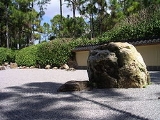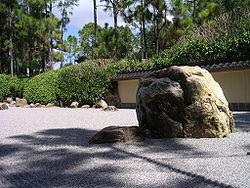
Roji-en Japanese Gardens
Encyclopedia
The Roji-en: Garden of the Drops of Dew, The George D. and Harriet W. Cornell Japanese Gardens consists of six gardens representing different periods in the development of the Japanese garden
. It occupies 16 acres (6.5 hectares) of the Morikami Museum and Japanese Gardens
in Morikami Park
in suburban Delray Beach
, Florida
, USA
. The gardens are open to the public, but closed Mondays and major holidays. Access to the gardens is included in the admission fee to the museum.
Today's gardens form one of the largest Japanese gardens in the world. They were designed by Hoichi Kurisu
and constructed between 1999 and 2001 in Morikami Park
, a 200 acre (80 hectare) site donated by George Morikami to Palm Beach County and Florida
in 1973. The Roji-en gardens are part of the Morikami Museum and Japanese Gardens
, reported to be the only museum in the United States dedicated to the living culture of Japan.
A survey conducted in 2004 by the Journal of Japanese Gardening ranked the Morikami gardens as the eighth highest-quality public Japanese garden in North America
.

Today's gardens were built in two phases. Phase One (completed in 1999) built the Yamato-kan pavilion, an historic stone lantern
, a tsukubai
(water basin), bonsai
display, Allen S. Austin Memorial Waterfall (designed by Carn Reid), a kame shima (turtle island), a Challenger Memorial Lantern, Yamato Island, the Morikami Falls, the Wisdom Ring, a dry creek garden and part of the seven acre (2.8 hectare) lake. The ishidoro lantern was originally erected in 1681 at Toshogu Shrine in Edo as a memorial to Ietsuna, the fourth Tokugawa
shogun. The Wisdom Ring is a replica of a stone lantern (ishidoro) located in Delray Beach's sister city in Japan, Miyazu. Phase Two (completed 2001) opened the six gardens.
Japanese garden
, that is, gardens in traditional Japanese style, can be found at private homes, in neighborhood or city parks, and at historical landmarks such as Buddhist temples, Shinto shrines and old castles....
. It occupies 16 acres (6.5 hectares) of the Morikami Museum and Japanese Gardens
Morikami Museum and Japanese Gardens
The Morikami Museum and Japanese Gardens is a center for Japanese arts and culture located west of Delray Beach in Palm Beach County, Florida, United States. The campus includes two museum buildings, the Roji-en Japanese Gardens: Garden of the Drops of Dew, a bonsai garden, a museum gift shop and...
in Morikami Park
Morikami Park
Morikami Park is named after George Morikami, who donated the land for the park to Palm Beach County. It is the site of the Morikami Museum and Japanese Gardens, the American Orchid Society Visitor Center and Botanical Garden, and the Biwa Pavilion, with group shelters and picnic tables...
in suburban Delray Beach
Delray Beach, Florida
Delray Beach is a city in Palm Beach County, Florida, USA. As of the 2000 census, the city had a total population of 60,020. As of 2004, the population estimated by the U.S...
, Florida
Florida
Florida is a state in the southeastern United States, located on the nation's Atlantic and Gulf coasts. It is bordered to the west by the Gulf of Mexico, to the north by Alabama and Georgia and to the east by the Atlantic Ocean. With a population of 18,801,310 as measured by the 2010 census, it...
, USA
United States
The United States of America is a federal constitutional republic comprising fifty states and a federal district...
. The gardens are open to the public, but closed Mondays and major holidays. Access to the gardens is included in the admission fee to the museum.
Today's gardens form one of the largest Japanese gardens in the world. They were designed by Hoichi Kurisu
Hoichi Kurisu
is a noted designer of Japanese gardens, active in the United States.Kurisu studied landscape design and construction under Kenzo Ogata in Tokyo, Japan. He then was Landscape director for the Garden Society of Japan , during which time he supervised construction of the Portland Japanese Garden...
and constructed between 1999 and 2001 in Morikami Park
Morikami Park
Morikami Park is named after George Morikami, who donated the land for the park to Palm Beach County. It is the site of the Morikami Museum and Japanese Gardens, the American Orchid Society Visitor Center and Botanical Garden, and the Biwa Pavilion, with group shelters and picnic tables...
, a 200 acre (80 hectare) site donated by George Morikami to Palm Beach County and Florida
Florida
Florida is a state in the southeastern United States, located on the nation's Atlantic and Gulf coasts. It is bordered to the west by the Gulf of Mexico, to the north by Alabama and Georgia and to the east by the Atlantic Ocean. With a population of 18,801,310 as measured by the 2010 census, it...
in 1973. The Roji-en gardens are part of the Morikami Museum and Japanese Gardens
Morikami Museum and Japanese Gardens
The Morikami Museum and Japanese Gardens is a center for Japanese arts and culture located west of Delray Beach in Palm Beach County, Florida, United States. The campus includes two museum buildings, the Roji-en Japanese Gardens: Garden of the Drops of Dew, a bonsai garden, a museum gift shop and...
, reported to be the only museum in the United States dedicated to the living culture of Japan.
A survey conducted in 2004 by the Journal of Japanese Gardening ranked the Morikami gardens as the eighth highest-quality public Japanese garden in North America
North America
North America is a continent wholly within the Northern Hemisphere and almost wholly within the Western Hemisphere. It is also considered a northern subcontinent of the Americas...
.
The six gardens
A mile-long path leads through six different Japanese gardens, representing six periods of Japanese garden design between the eighth and 20th centuries. The grounds feature pine trees, bamboo groves, waterfalls and large granite boulders.
- Shinden Gardens - HeianHeian periodThe is the last division of classical Japanese history, running from 794 to 1185. The period is named after the capital city of Heian-kyō, or modern Kyōto. It is the period in Japanese history when Buddhism, Taoism and other Chinese influences were at their height...
period (9th - 12th centuries); aristocratic gardens patterned after Chinese gardenChinese gardenThe Chinese garden, also known as a Chinese classical garden, is a style of landscape garden which has evolved for more than three thousand years, and which is inspired by Chinese literature, Chinese painting and Chinese philosophy...
s, featuring ponds and islands.
- Paradise Gardens - (13th and 14th century); influenced by Buddhist teachings, and incorporating hills, ponds and islands. Similar to the Shinden Gardens but on a smaller scale.
- Early Rock Gardens - abstracted vegetation and water, with rock arrangements to represent waterfalls and streambeds.
- Late Rock Gardens - (15th century) karesansui gardens almost entirely constructed of gravel, stone and sand.
- Flat Gardens - (16th and 17th century) shakkeiShakkei and the picturesqueBorrowed scenery is the principle of "incorporating background landscape into the composition of a garden" found in traditional East Asian garden design. The term "borrowed scenery" is Chinese in origin...
, or borrowed landscape.
- Modern Romantic Gardens - (EdoEdo, also romanized as Yedo or Yeddo, is the former name of the Japanese capital Tokyo, and was the seat of power for the Tokugawa shogunate which ruled Japan from 1603 to 1868...
period and later) stroll gardens influenced by Western European gardens.
Today's gardens were built in two phases. Phase One (completed in 1999) built the Yamato-kan pavilion, an historic stone lantern
Tōrō
A "灯篭" is just a simplified form of "灯籠". is a Japanese lantern made of stone, wood, or metal traditional in the Far East. In China extant specimen are very rare, and in Korea too they are not as common as in Japan. In Japan, tōrō were originally used only in Buddhist temples, where they lined and...
, a tsukubai
Tsukubai
A is a small basin provided in Japanese Buddhist temples for visitors to purify themselves by the ritual washing of hands and rinsing of the mouth . This type of ritual cleansing is also the custom for guests attending a tea ceremony....
(water basin), bonsai
Bonsai
is a Japanese art form using miniature trees grown in containers. Similar practices exist in other cultures, including the Chinese tradition of penjing from which the art originated, and the miniature living landscapes of Vietnamese hòn non bộ...
display, Allen S. Austin Memorial Waterfall (designed by Carn Reid), a kame shima (turtle island), a Challenger Memorial Lantern, Yamato Island, the Morikami Falls, the Wisdom Ring, a dry creek garden and part of the seven acre (2.8 hectare) lake. The ishidoro lantern was originally erected in 1681 at Toshogu Shrine in Edo as a memorial to Ietsuna, the fourth Tokugawa
Tokugawa shogunate
The Tokugawa shogunate, also known as the and the , was a feudal regime of Japan established by Tokugawa Ieyasu and ruled by the shoguns of the Tokugawa family. This period is known as the Edo period and gets its name from the capital city, Edo, which is now called Tokyo, after the name was...
shogun. The Wisdom Ring is a replica of a stone lantern (ishidoro) located in Delray Beach's sister city in Japan, Miyazu. Phase Two (completed 2001) opened the six gardens.

